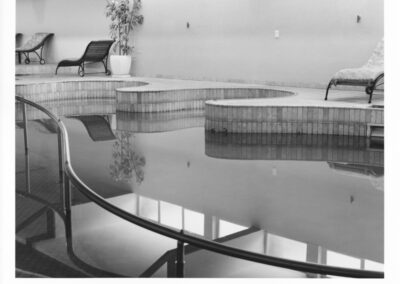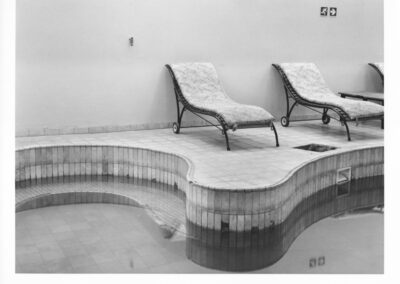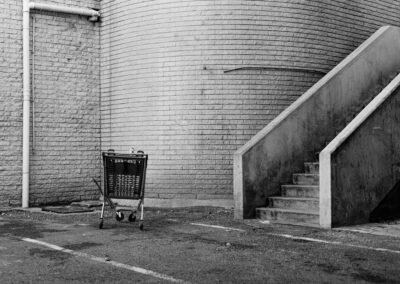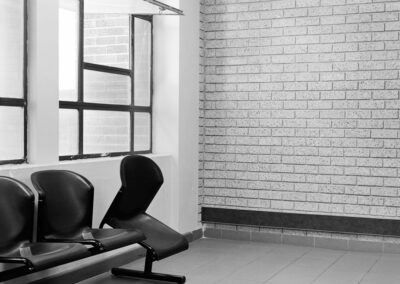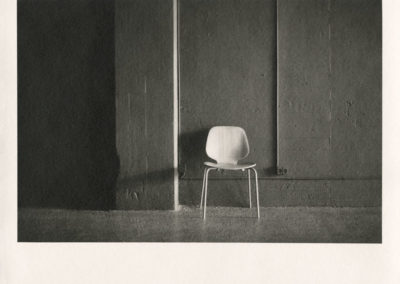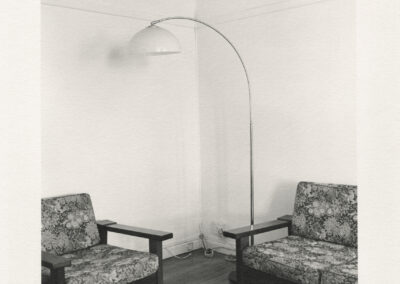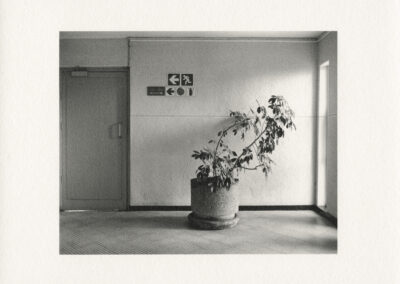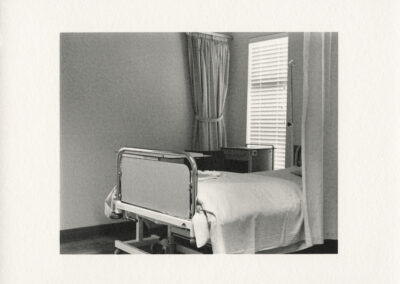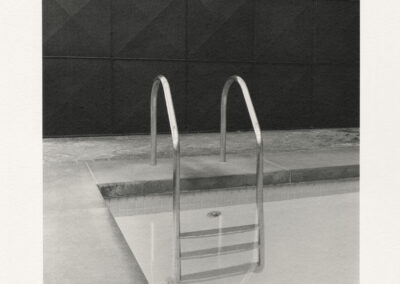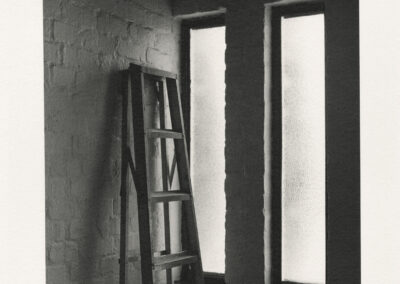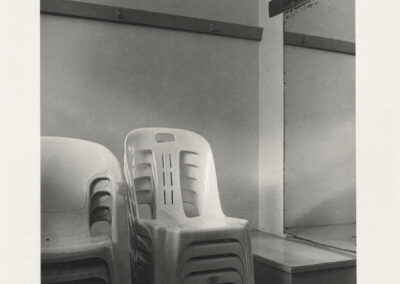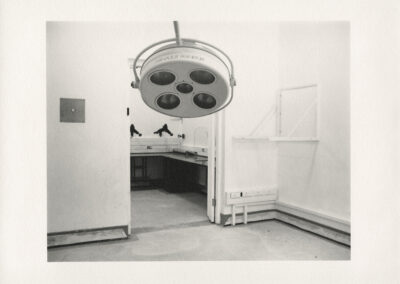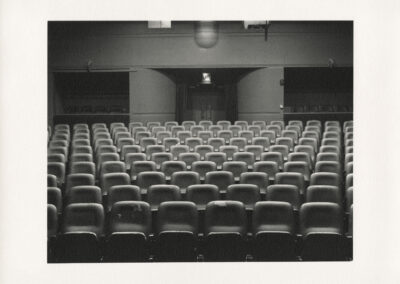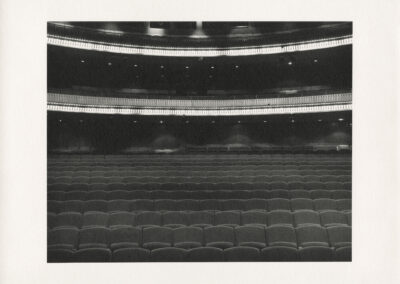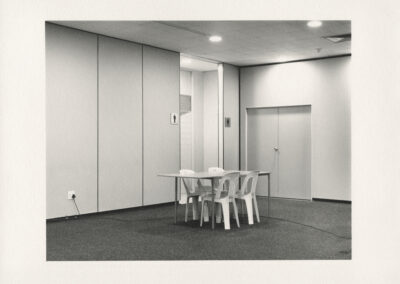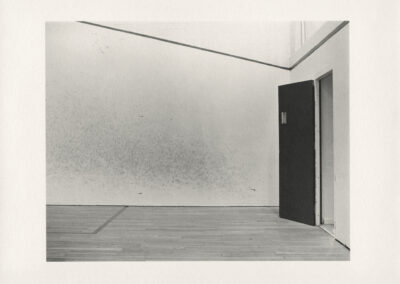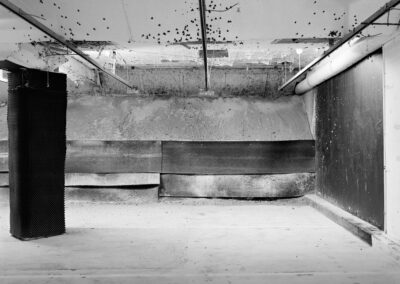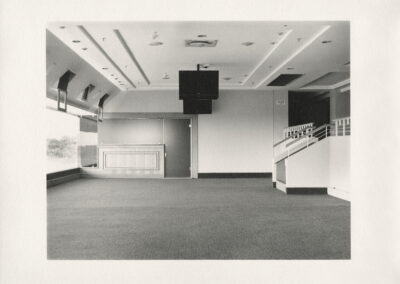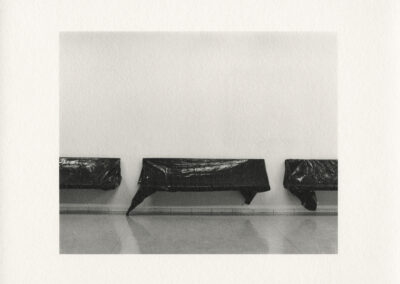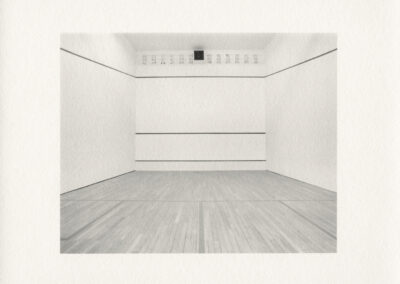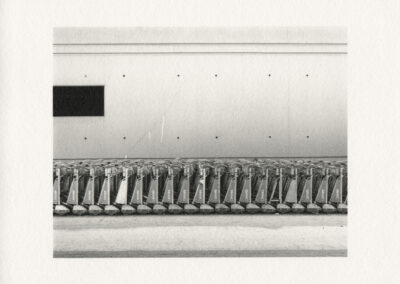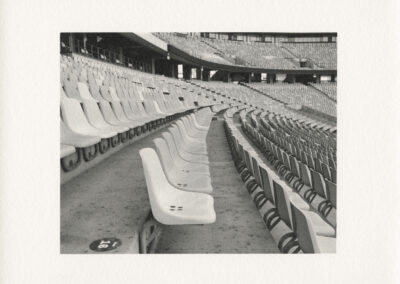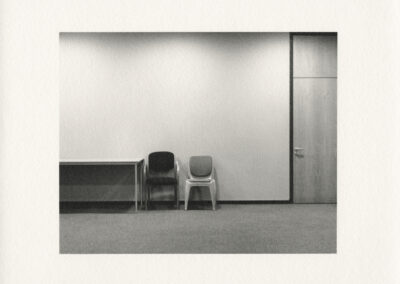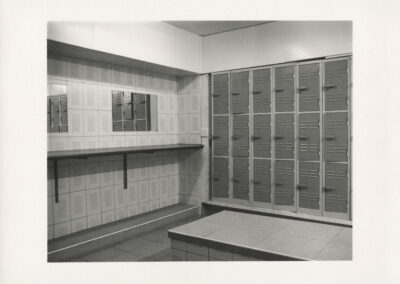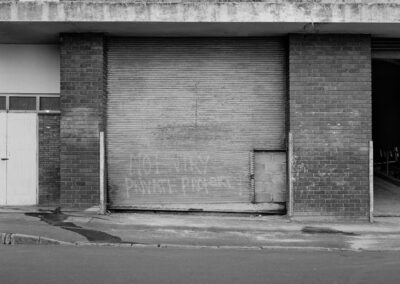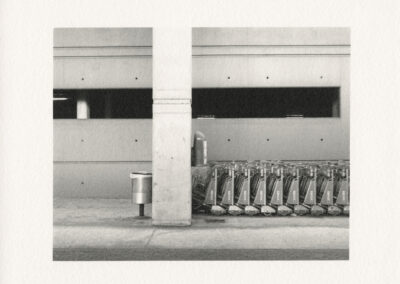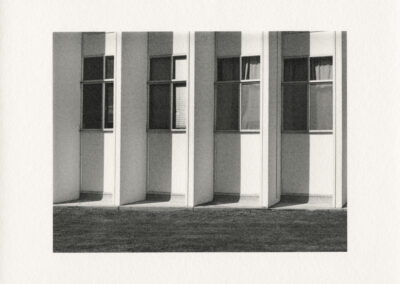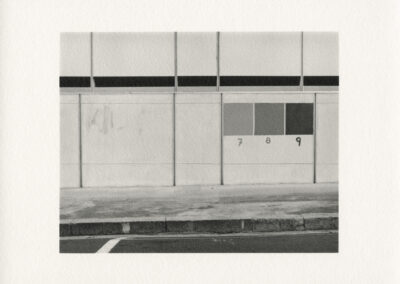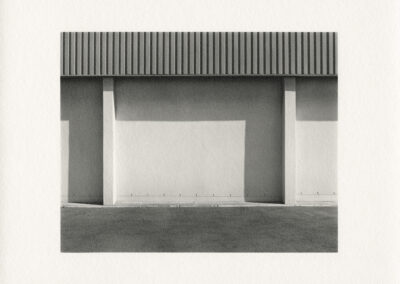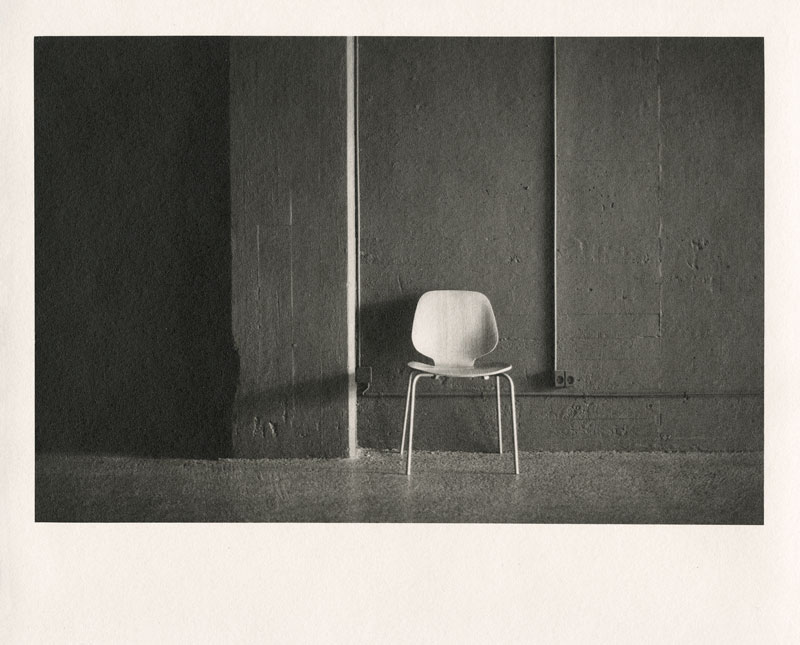
Nicole Clare Fraser
Fraser has been working with elements of ‘Absence, Stillness and the In-Between in Public Spaces’ in her artistic practice for some time, this body of work did not stem from the sudden emptiness of space, but instead the abandoned places she photographed presented a unique opportunity relevant to her artistic thesis while devoid of their usual bustle.
Nicole Clare Fraser’s solo exhibition at DAOR Contemporary, 2023, Making Space explores banal and commonplace empty spaces, non-places, liminal spaces, and ordinary, inanimate objects experienced as a state of ‘emptiness’. The visual language is an important element, interrogating perceptions of ‘neutral’ or ‘objective’ ways of seeing. The body of work reflects the absence and stillness of lockdown Cape Town.
Nicole Clare Fraser, Untitled III, Hand-Printed Silver Gelatin Print – Printed 2020 by Dennis Da Silva, 50 x 60 (framed 59 x 70), 2019, 2/2 + AP
Nicole Clare Fraser, Untitled II, Hand-Printed Silver Gelatin Print – Printed 2020 by Dennis Da Silva, 50 x 60 (framed 59 x 70), 2019, 2/2 + AP
Nicole Clare Fraser, Untitled I, Hand-Printed Silver Gelatin Print – Printed 2020 by Dennis Da Silva, 50 x 60 (framed 59 x 70), 2019, 2/2 + AP
Nicole Clare Fraser, Gallows Hills Traffic Department III, 2021, archival ink on innova 300gsm, 91,5 x 114 cm, Edition 1 of 3
Nicole Clare Fraser, Untitled Greenhouse with Waterlillies, Hand printed silver gelatin on 100% cotton rag, 2017 Edition of 5, 47 x 52cm
Nicole Clare Fraser, Untitled 5 Chair, Hand printed silver gelatin on 100% cotton rag, 2017 Edition of 5, 27,6 x 20cm
Home, 2020, Silver gelatin handprint, Image size 300 x 240 mm, Paper size 400 x 300 mm, Edition of 3 + AP
Apartment Block, 2020, Silver gelatin handprint, Image size 140 x 175 mm, Paper size 200 x 250 mm, Edition of 3 + AP
Reclining Beds, 2020, Silver gelatin handprint, Image size 240 x 300 mm, Paper size 300 x 400 mm, Edition of 3 + AP
Fertility Clinic Bed, 2021, Silver gelatin handprint, Image size 140 x 175 mm, Paper size 200 x 250 mm, Edition of 3 + AP
Dressing Room 2020 Silver gelatin handprint Image size 240 x 300 mm Paper size 300 x 400 mm Edition of 3 + AP
Pool Ladder 2020 Silver gelatin handprint Image size 300 x 240 mm Paper size 400 x 300 mm Edition of 3 + AP
Ladder 2020 Silver gelatin handprint Image size 300 x 240 mm Paper size 400 x 300 mm Edition of 3 + AP
Stacked Plastic Chairs 2020 Silver gelatin handprint Image size 300 x 240 mm Paper size 400 x 300 mm Edition of 3 + AP
Swimming Pool 2020 Silver gelatin handprint Image size 240 x 300 mm Paper size 300 x 400 mm Edition of 3 + AP
Fertility Clinic 2021 Silver gelatin handprint Image size 240 x 300 mm Paper size 300 x 400 mm Edition of 3 + AP
Gallows Hills Traffic Department I 2021 Archival ink on Innova 300gsm cotton rag paper Image size 704,2 x 880,2 mm Paper size 915 x 1140 mm Edition of 3 + AP
The Little Theatre 2020 Silver gelatin handprint Image size 240 x 300 mm Paper size 300 x 400 mm Edition of 3 + AP
Baxter Theatre 2020 Silver gelatin handprint Image size 240 x 300 mm Paper size 300 x 400 mm Edition of 3 + AP
Shooting Range II 2021 Silver gelatin handprint Image size 140 x 175 mm Paper size 200 x 250 mm Edition of 3 + AP
Gallows Hill Traffic department II 2021 Silver gelatin handprint Image size 140 x 175 mm Paper size 200 x 250 mm Edition of 3 + AP
Civic Centre Dining Hall 2021 Silver gelatin handprint Image size 240 x 300 mm Paper size 300 x 400 mm Edition of 3 + AP
Stadium 2020 Silver gelatin handprint Image size 240 x 300 mm Paper size 300 x 400 mm Edition of 3 + AP
Squash Court I 2020 Silver gelatin handprint Image size 240 x 300 mm Paper size 300 x 400 mm Edition of 3 + AP
Shooting Range I 2021 Silver gelatin handprint Image size 140 x 175 mm Paper size 200 x 250 mm Edition of 3 + AP
Factory 2020 Silver gelatin handprint Image size 300 x 240 mm Paper size 400 x 300 mm Edition of 3 + AP
Racecourse Hall and TV Screens 2020 Silver gelatin handprint Image size 240 x 300 mm Paper size 300 x 400 mm Edition of 3 + AP
Pillars and Chairs 2020 Silver gelatin handprint Image size 240 x 300 mm Paper size 300 x 400 mm Edition of 3 + AP
Racecourse Staircase 2020 Silver gelatin handprint Image size 140 x 175 mm Paper size 200 x 250 mm Edition of 3 + AP
High School Locker Room 2020 Silver gelatin handprint Image size 140 x 175 mm Paper size 200 x 250 mm Edition of 3 + AP
Campus Benches 2021 Silver gelatin handprint Image size 140 x 175 mm Paper size 200 x 250 mm Edition of 3 + AP
Line of Seating 2021 Silver gelatin handprint Image size 140 x 175 mm Paper size 200 x 250 mm Edition of 3 + AP
Sports Centre 2021 Silver gelatin handprint Image size 140 x 175 mm Paper size 200 x 250 mm Edition of 3 + AP
Empty Pool 2020 Silver gelatin handprint Image size 140 x 175 mm Paper size 200 x 250 mm Edition of 3 + AP
Squash Court II 2020 Silver gelatin handprint Image size 140 x 175 mm Paper size 200 x 250 mm Edition of 3 + AP
Airport Trolleys II 2021 Silver gelatin handprint Image size 140 x 175 mm Paper size 200 x 250 mm Edition of 3 + AP
Stadium I 2020 Silver gelatin handprint Image size 140 x 175 mm Paper size 200 x 250 mm Edition of 3 + AP
Stadium II 2020 Silver gelatin handprint Image size 140 x 175 mm Paper size 200 x 250 mm Edition of 3 + AP
Two Chairs 2021 Silver gelatin handprint Image size 140 x 175 mm Paper size 200 x 250 mm Edition of 3 + AP
Changing Room 2020 Silver gelatin handprint Image size 240 x 300 mm Paper size 300 x 400 mm Edition of 3 + AP
Underground Parking 2020 Silver gelatin handprint Image size 240 x 300 mm Paper size 300 x 400 mm Edition of 3 + AP
Garage Door 2020 Archival ink on Innova 300gsm cotton rag paper Image size 704,2 x 880,2 mm Paper size 915 x 1140 mm Edition of 3 + AP
Airport Trolleys I 2021 Silver gelatin handprint Image size 140 x 175 mm Paper size 200 x 250 mm Edition of 3 + AP
Doorway with Surveillance Camera 2021 Archival ink on Innova 300gsm cotton rag paper Image size 704,2 x 880,2 mm Paper size 915 x 1140 mm Edition of 3 + AP
Building Exterior 2020 Silver gelatin handprint Image size 140 x 175 mm Paper size 200 x 250 mm Edition of 3 + AP
Building Façade 2021 Silver gelatin handprint Image size 140 x 175 mm Paper size 200 x 250 mm Edition of 3 + AP

